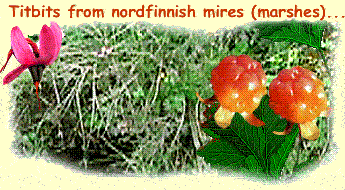Mire types can roughly be divided in three different groups:
Pine mires: typical species pine (Pinus silvestris), cotton grass (Eriophorum vaginatum), arctic cloudberry (Rubus chamaemorus), many dwarf shrubs (like bog rosemary, Andromeda polifolia) and sphagnum-mosses (e.g. Sphagnum fuscum) etc. Usually poor, but there are some eutrophic pine mires (in Finn. = lettoräme), too.
Spruce mires: thriving usually close to the flowing water. Typical species spruce (Picea abies) and/or birch (Betula pubescens), bilberry (Vaccinium myrtillus) and herbaceous species, not so many dwarf shrubs than in pine mires, some sphagnum-mosses (like S. girgensohnii). Minerotrophic, not so poor than most of pine mires (and other ombrotrophic bogs). There are some eutrophic spruce mires (in Finn. = lehtokorpi, saniaiskorpi and ruoho- ja heikäkorpi).
Open mires (two groups):
- Open poor mires: treeless, usually dominated by different sedge (Carex) species (minerotrophic fens) or by Eriophorum species (ombrotrophic bogs).
- Eutrophic fens: richer in nutrients than other open mires, several herbaceous, Carex species and Bryales-mosses.
----
- Sphagnum mosses are abundant in all types, and other moss species also in eutrophic mires.
- Oligotrophic - eutrophic, see also: forests and waters! |







